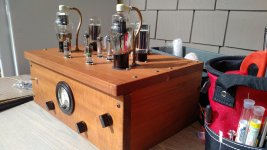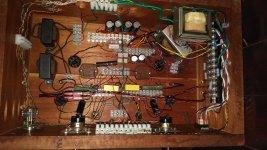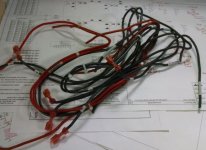I have some nice new old stock 6BG6G tubes I intend to put to use (mentioned in another thread) and they have top caps for the plates.
I have some nice ceramic caps, but I'm not sure what kind of wire to use for them. The usual hookup wire I use is 22 gauge solid, but that looks kind of wimpy in this use. I was thinking about some of that reproduction cloth wire I've seen listed on eBay, but then I thought I'd better ask what the brain trust here thinks.
Best wire for the plate (top cap) on a 6BG6G tube? Thanks!
I have some nice ceramic caps, but I'm not sure what kind of wire to use for them. The usual hookup wire I use is 22 gauge solid, but that looks kind of wimpy in this use. I was thinking about some of that reproduction cloth wire I've seen listed on eBay, but then I thought I'd better ask what the brain trust here thinks.
Best wire for the plate (top cap) on a 6BG6G tube? Thanks!
You need wire with insulation rated for the voltage that is present. McMaster-Carr has 600 V. rated, silicone rubber insulated, wire that fills the requirement.
I've used thick gauge wires used for motorcycle battery connection. Cheap spark plug wires will work also (the solid core, not the carbon ones), perhaps best for this application as we are sure the insulation can handle the high voltage.
Eli's suggestion is good. I have also used silicone slot car wire, which is flexible enough to drape attractively from tube cap to chassis. Size 18 ga is about the right size to fit the tube cap. Voltage rating is uncertain, but the insulation certainly looks thick enough for the job at hand. Remember to use a rubber grommet for strain relief and/or chafe protection when passing the wires through the top deck.
Plate caps are fussy - the current Chinese production 1/4" caps fit loosely, and loosen up more with use. I try to stick to NOS stock from National or Millen, though those are hard to find these days.
Plate caps are fussy - the current Chinese production 1/4" caps fit loosely, and loosen up more with use. I try to stick to NOS stock from National or Millen, though those are hard to find these days.
I agree with wrenchone that the current Chinese caps are worse than useless (i.e. dangerous). A forum member (can't remember who) suggested using fuse holders; these work really well if you are prepared to take care of the insulation in some other way.
I have used probe wire from an old dead multimeter. They are exactly right for the application.
Shoog
Shoog
I wouldn't use 600V wire on output stages that will swing voltages above 600V (remember that inductively-loaded stages can swing twice the B+ voltage).
I bought a roll of wire from Mouser that was marketed as "test lead wire" and rated for 5000V. The insulation was considerably thicker than 600V wire. It was not expensive.
http://www.mouser.com/ProductDetail/Pomona-Electronics/6734-2/?qs=sGAEpiMZZMtW9UaYX5J1tBhlaH3DQ7LsHVIiSs9YVXY%3d
I bought a roll of wire from Mouser that was marketed as "test lead wire" and rated for 5000V. The insulation was considerably thicker than 600V wire. It was not expensive.
http://www.mouser.com/ProductDetail/Pomona-Electronics/6734-2/?qs=sGAEpiMZZMtW9UaYX5J1tBhlaH3DQ7LsHVIiSs9YVXY%3d
Worst case plate voltage is usually no more than 2X B+.
Partly depends on whether it is SE or Push Pull.
Partly depends on whether the load has mistakenly been removed.
Partly depends on the loudspeaker impedance at some frequency, versus a large signal at that frequency.
Meter wires is a good idea. Meter wires are Voltage rated. Not all have the same rating though.
Partly depends on whether it is SE or Push Pull.
Partly depends on whether the load has mistakenly been removed.
Partly depends on the loudspeaker impedance at some frequency, versus a large signal at that frequency.
Meter wires is a good idea. Meter wires are Voltage rated. Not all have the same rating though.
Best wire for the plate (top cap) on a 6BG6G tube? Thanks!
Stranded silicone 3kV-10kV HV wire for sure. No cloth!
https://www.amazon.com/uxcell-Lengt...1493318821&sr=1-1&keywords=10kv+stranded+wire
https://www.amazon.com/uxcell-Meter...1493318884&sr=1-3&keywords=10kv+stranded+wire
https://www.amazon.com/Rowe-R800-St...84&sr=1-3-catcorr&keywords=10kv+stranded+wire
Last edited:
As others said, Chinese top caps are awful and don't hold their tension very well at all. For my 1625 and EL38 amps, I took the extra pains to find some vintage caps to use.
I used some 1000V rated wire - doubled sheathed - that I bought on Ebay.
I used some 1000V rated wire - doubled sheathed - that I bought on Ebay.
As others said, Chinese top caps are awful and don't hold their tension very well at all. For my 1625 and EL38 amps, I took the extra pains to find some vintage caps to use.
I used some 1000V rated wire - doubled sheathed - that I bought on Ebay.
I find the Chinese caps work fine if a small blob of solder is added if there is any looseness . As others have mentioned here : stripped out 20mm fuseholders work . You can also roll copper shim stock around a 5.5mm drill bill to manufacture your own topcap conenctors
316a
You guys have given me some really great suggestions, thank you so much! I will also look into those vintage ceramic caps as well. Really appreciate the great information!
The silicone test lead wire is ideal -flexible and has a high voltage and temperature ratings.
I agree with this as the best option.
I just finished an amp with 1625 top caps. I thought for weeks how to make it pet safe. I found a solution.
I used copper tubing that fit into the ceramic top cap and took out the clip leaving only the ceramic. I then used a collar with a set screw attached to the chassis that the copper tube fit in. I then fed test leader wire through the tube into the ceramic cap and put the bare part of the wire along the top of the cap. I left about 1/4" of insulated wire between the stripped wire and copper tubing.
I lined up the top cap and put the cap firmly on the anode of the tube and the tightened down the set screw...the tube, copper tubing and top cap are firmly in place and do not move even when I pull or try to wiggle the tubing and or top cap.
The bonus is there is no clip to pull the anode cap off of the tube, which often happens with old tubes.
The bottom pic shows the tubing poking through the bottom.
I was lucky enough to find thinner test lead wire that has rubber insulation, but silicone would be better.
The tubing is 1/8" copper tubing with a thinner brass tube soldered onto the edge. I then used shrink tube to ensure a snug, but not too tight of a fit to allow expansion of the copper tube and crack the ceramic cap.
Attachments
Last edited:
Here's some wire I just grabbed from the copper scrap bin at lunchtime - it's marked 20 KV. Gonna miss these trash bins when I retire in a month...
Where I work, I am surrounded by such things. If I were to take so much as a post-it note, I'd be fired within minutes, so I don't. I wish I could, especially from the bins marked 'scrap'. But it is what it is. They say no, so I don't do it.
- Status
- Not open for further replies.
- Home
- Amplifiers
- Tubes / Valves
- What wire to use for top caps (plate voltage)?


